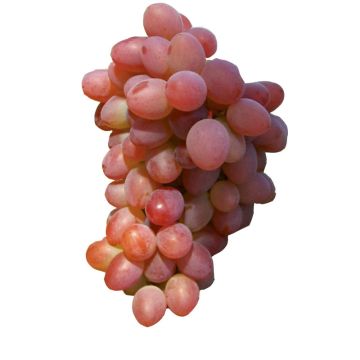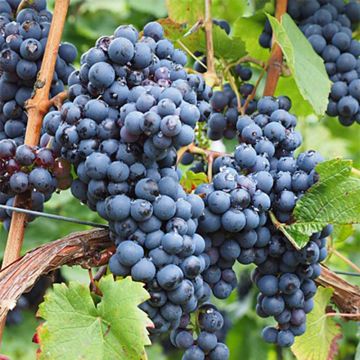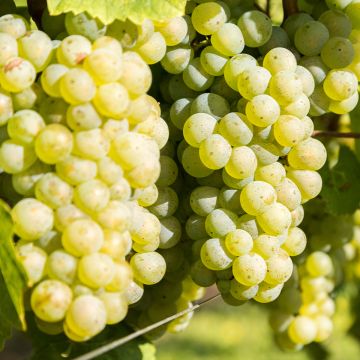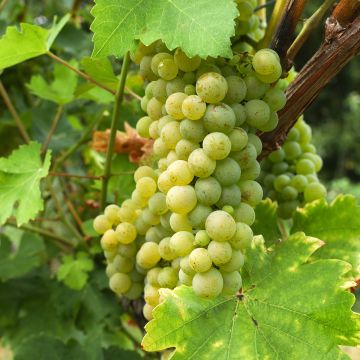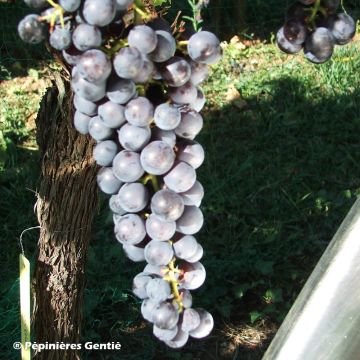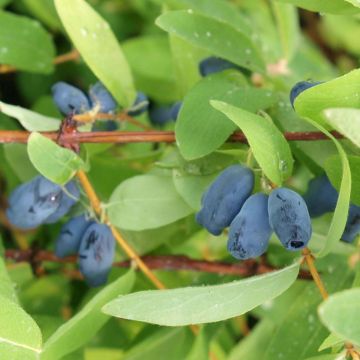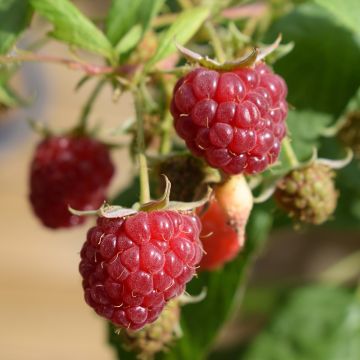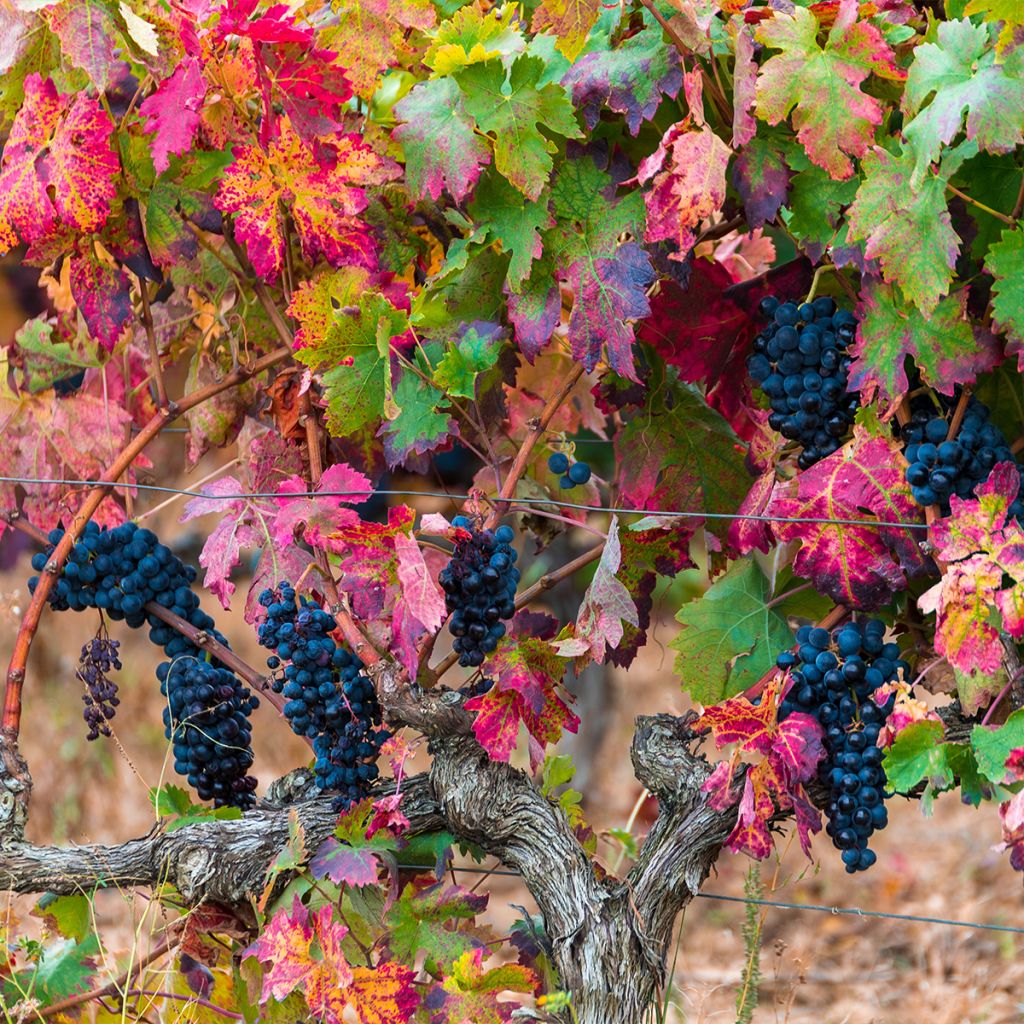

Vitis vinifera Brant - Grape vine
Vitis vinifera Brant - Grape vine
Vitis vinifera Brant
Common Grape Vine, European Grape, Wine Grape
Why not try an alternative variety in stock?
View all →This plant carries a 6 months recovery warranty
More information
We guarantee the quality of our plants for a full growing cycle, and will replace at our expense any plant that fails to recover under normal climatic and planting conditions.
From €5.90 for pickup delivery and €6.90 for home delivery
Express home delivery from €8.90.
Delivery to Corse prohibited: UE law prohibits the import of this plant from mainland France to Corse as part of the fight against Xylella fastidiosa. Please accept our sincere apologies.
More information
Description
An original variety if there ever was one, Brant is an ornamental vine that bears abundant fruit. Particularly vigorous, it can reach a height of 8m (26ft) or more if not pruned to limit its size. Its greenish flowering in June is not particularly interesting, but it then produces clusters of decorative black grapes in September and October. Its foliage, on the other hand, takes on rich red hues in autumn, with the central veins remaining green, giving it a certain aesthetic appeal. This variety is very hardy (down to -20°C (-4°F)) and prefers neutral to alkaline, well-drained soil, in full sun. It is somewhat susceptible to mildew and botrytis.
The wine grapevine (Vitis vinifera) grew wild over 5000 years ago in North and Central America, Europe, and Central and Eastern Asia. The subspecies sylvestris still exists, and it is a climbing liana that grows on the edge of forests and can reach great heights in trees. The current varieties, referred to as "grape varieties" in the case of the vine, are classified under the vinifera subspecies (although there are other cultivated species, but they are very minor). Economically, wine grapes predominate over table grapes.
Alongside the vinifera species, there are other species, some of which have been used to create hybrids. This is the case with the Brant Vine, which has genes from Vitis vinifera, Vitis labrusca - the American raspberry vine with fruits that taste like raspberries - and Vitis riparia, the riverbank vine, whose branches can reach up to 20m (66ft) in length. "Brant" is more specifically the result of cross-breeding done in Canada by breeder Charles Arnold between the Clinton variety (itself a natural hybrid of Vitis labrusca and Vitis riparia selected in 1821 in the state of New York) and the Black St. Peters variety (or Black Alicante due to its Spanish origin, a red table grape consumed since the 18th century).
This Vitis Brant has vigorous growth, but it can be pruned to limit its development. Its leaves have 3 to 5 more or less pronounced lobes and are finely toothed. With their tendrils, its stems are capable of covering a trellis or arbour with a veritable leafy mantle. In June, the plant produces clusters of small greenish flowers that are quite insignificant from an ornamental point of view, but interesting in the sense that they are self-fertile and develop into true fruit clusters like "classic" varieties of Vitis vinifera. The resulting grapes are black with a slightly bluish bloom. They are generally not consumed, especially as they are known to be full of seeds, but they beautifully decorate the plant during the months of September and October... as long as the birds don't devour them! They release aromatic notes in the garden, likely inherited from their parent Vitis lambrusca. Vinification trials have reportedly produced a decent wine. What is certain is that its grapes are highly decorative in autumn, heralding a new spectacle as the foliage begins to colour due to the first cold spells. It then takes on vivid red to crimson hues, while the veins remain green-yellow, creating a particularly attractive visual contrast.
Growing in full sun in neutral to alkaline, well-drained soil, this variety is hardy to approximately -20°C (-4°F) and can be cultivated almost anywhere. It is moderately susceptible to mildew and botrytis (grey mold), diseases whose early signs should be monitored in order to treat them promptly. Uncontrolled mildew can defoliate a vine, which would be a shame in the case of Brant, whose main ornamental interest lies in the autumn colours of its foliage!
Brant is not the only vine with ornamental foliage, Vitis coignetiae also takes on stunning colours in autumn. But it is also interesting because of its clusters of decorative fruits, which makes it similar to Vitis vinifera 'Purpurea', which also bears clusters of black fruits and has purple foliage in season. To create a spectacular contrasting scene, plant the Golden Hop alongside them, whose trilobed leaves, reminiscent of those of the vine, will stand out with their bright colour.
Report an error about the product description
Vitis vinifera Brant - Grape vine in pictures


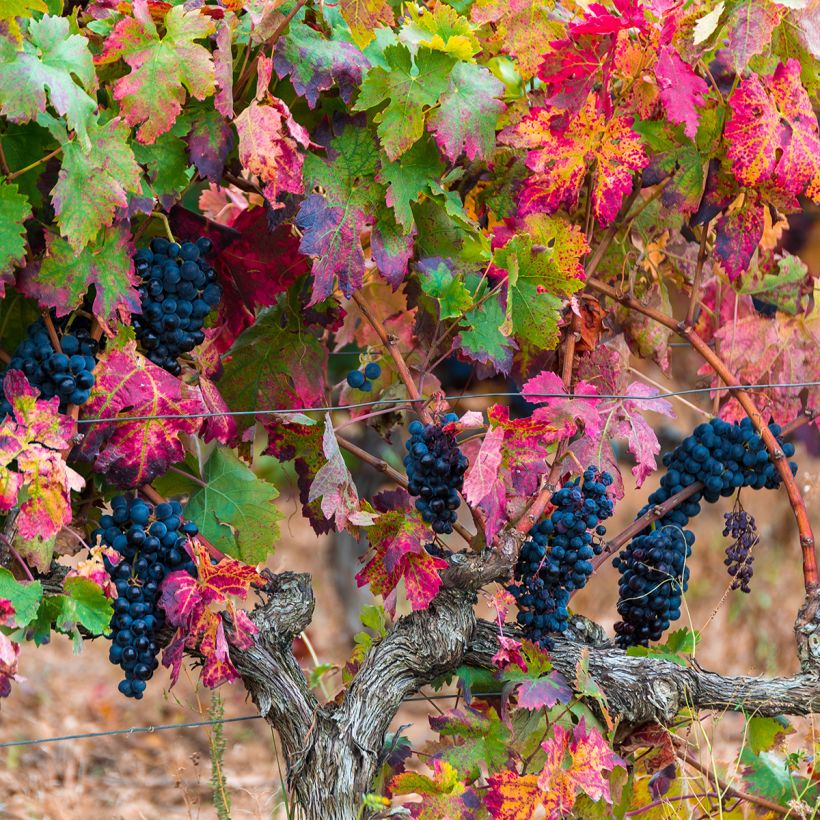



Plant habit
Fruit
Flowering
Foliage
Botanical data
Vitis
vinifera
Brant
Vitaceae
Common Grape Vine, European Grape, Wine Grape
Cultivar or hybrid
Other Grapevines
Planting and care
Plant the Brant vine in autumn, in a deep, well-drained soil, even stony, clayey and chalky, knowing that the vine is not demanding regarding the chemical nature of the soil. It is capable of adapting to moderately acidic soil (to pH 6 approximately, as below this there are assimilation blocks of certain trace elements), neutral, or alkaline up to pH 8.5 approximately (knowing that in this case, it is actually the excess of active lime that is detrimental).
Install it in a sunny exposure, sheltered from strong, cold and dry winds. This variety can withstand winter frosts down to -20°C (-4°F), or even lower in well-drained soil. Incorporate 3 or 4 handfuls of fruit tree fertiliser and 2 kg of composted manure into the planting soil. Be careful, the roots should not be in contact with the manure.
The vine does not require regular fertiliser application for good yield, on the contrary. In soil that is too rich, vegetation (leaves) will develop at the expense of fruiting. Enrich the soil with potash slag, crushed horn or iron chelate, only every 2-3 years.
This vine can be susceptible to mildew and botrytis (grey rot). Therefore, monitor its health condition in order to treat it in time with copper-based products.
Planting period
Intended location
Care
This item has not been reviewed yet - be the first to leave a review about it.
Berries
Haven't found what you were looking for?
Hardiness is the lowest winter temperature a plant can endure without suffering serious damage or even dying. However, hardiness is affected by location (a sheltered area, such as a patio), protection (winter cover) and soil type (hardiness is improved by well-drained soil).

Photo Sharing Terms & Conditions
In order to encourage gardeners to interact and share their experiences, Promesse de fleurs offers various media enabling content to be uploaded onto its Site - in particular via the ‘Photo sharing’ module.
The User agrees to refrain from:
- Posting any content that is illegal, prejudicial, insulting, racist, inciteful to hatred, revisionist, contrary to public decency, that infringes on privacy or on the privacy rights of third parties, in particular the publicity rights of persons and goods, intellectual property rights, or the right to privacy.
- Submitting content on behalf of a third party;
- Impersonate the identity of a third party and/or publish any personal information about a third party;
In general, the User undertakes to refrain from any unethical behaviour.
All Content (in particular text, comments, files, images, photos, videos, creative works, etc.), which may be subject to property or intellectual property rights, image or other private rights, shall remain the property of the User, subject to the limited rights granted by the terms of the licence granted by Promesse de fleurs as stated below. Users are at liberty to publish or not to publish such Content on the Site, notably via the ‘Photo Sharing’ facility, and accept that this Content shall be made public and freely accessible, notably on the Internet.
Users further acknowledge, undertake to have ,and guarantee that they hold all necessary rights and permissions to publish such material on the Site, in particular with regard to the legislation in force pertaining to any privacy, property, intellectual property, image, or contractual rights, or rights of any other nature. By publishing such Content on the Site, Users acknowledge accepting full liability as publishers of the Content within the meaning of the law, and grant Promesse de fleurs, free of charge, an inclusive, worldwide licence for the said Content for the entire duration of its publication, including all reproduction, representation, up/downloading, displaying, performing, transmission, and storage rights.
Users also grant permission for their name to be linked to the Content and accept that this link may not always be made available.
By engaging in posting material, Users consent to their Content becoming automatically accessible on the Internet, in particular on other sites and/or blogs and/or web pages of the Promesse de fleurs site, including in particular social pages and the Promesse de fleurs catalogue.
Users may secure the removal of entrusted content free of charge by issuing a simple request via our contact form.
The flowering period indicated on our website applies to countries and regions located in USDA zone 8 (France, the United Kingdom, Ireland, the Netherlands, etc.)
It will vary according to where you live:
- In zones 9 to 10 (Italy, Spain, Greece, etc.), flowering will occur about 2 to 4 weeks earlier.
- In zones 6 to 7 (Germany, Poland, Slovenia, and lower mountainous regions), flowering will be delayed by 2 to 3 weeks.
- In zone 5 (Central Europe, Scandinavia), blooming will be delayed by 3 to 5 weeks.
In temperate climates, pruning of spring-flowering shrubs (forsythia, spireas, etc.) should be done just after flowering.
Pruning of summer-flowering shrubs (Indian Lilac, Perovskia, etc.) can be done in winter or spring.
In cold regions as well as with frost-sensitive plants, avoid pruning too early when severe frosts may still occur.
The planting period indicated on our website applies to countries and regions located in USDA zone 8 (France, United Kingdom, Ireland, Netherlands).
It will vary according to where you live:
- In Mediterranean zones (Marseille, Madrid, Milan, etc.), autumn and winter are the best planting periods.
- In continental zones (Strasbourg, Munich, Vienna, etc.), delay planting by 2 to 3 weeks in spring and bring it forward by 2 to 4 weeks in autumn.
- In mountainous regions (the Alps, Pyrenees, Carpathians, etc.), it is best to plant in late spring (May-June) or late summer (August-September).
The harvesting period indicated on our website applies to countries and regions in USDA zone 8 (France, England, Ireland, the Netherlands).
In colder areas (Scandinavia, Poland, Austria...) fruit and vegetable harvests are likely to be delayed by 3-4 weeks.
In warmer areas (Italy, Spain, Greece, etc.), harvesting will probably take place earlier, depending on weather conditions.
The sowing periods indicated on our website apply to countries and regions within USDA Zone 8 (France, UK, Ireland, Netherlands).
In colder areas (Scandinavia, Poland, Austria...), delay any outdoor sowing by 3-4 weeks, or sow under glass.
In warmer climes (Italy, Spain, Greece, etc.), bring outdoor sowing forward by a few weeks.


































